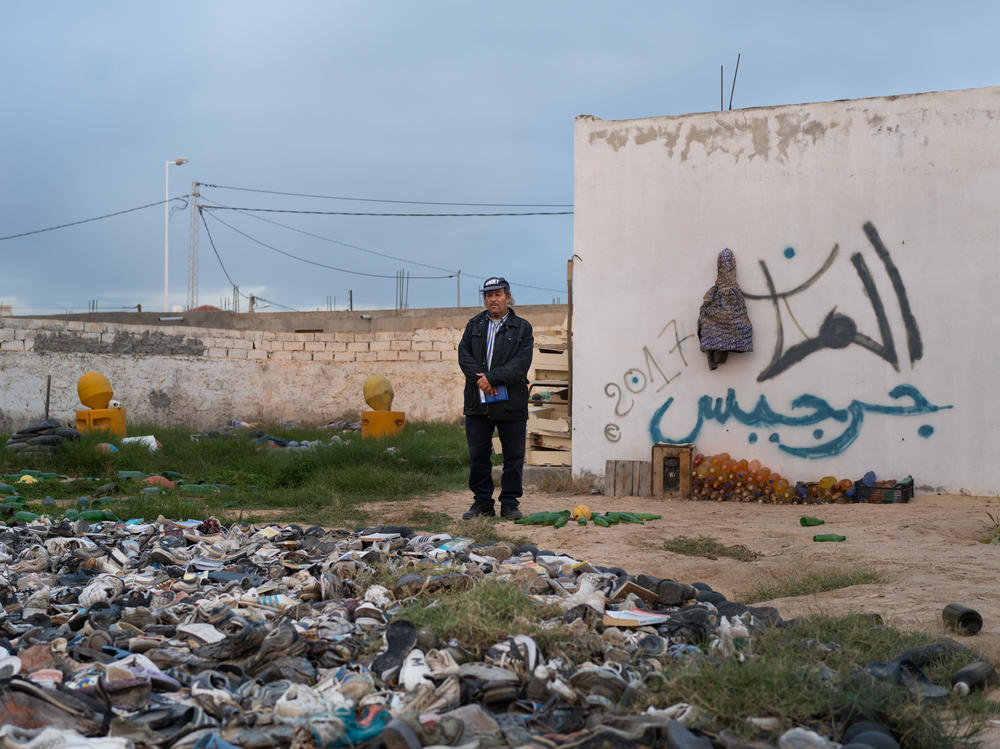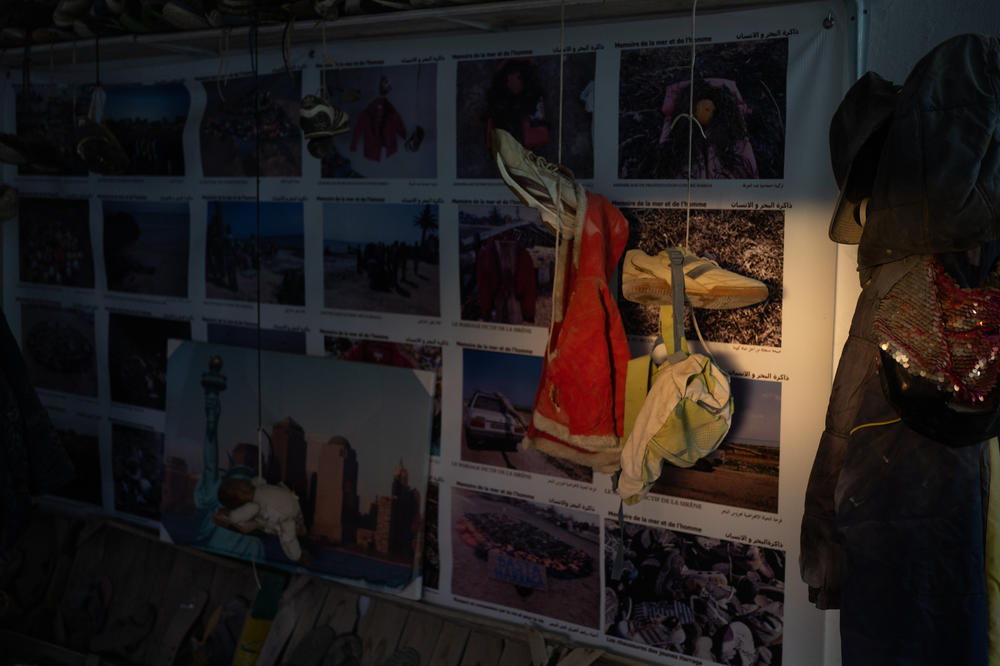Section Branding
Header Content
A Tunisian artist is hoping to keep the memories of migrants alive
Primary Content
ZARZIS, TUNISIA — The coastal city of Zarzis in southeast Tunisia is where Mohsen Lihidheb makes and displays his art.
Through a blue door, with two handwritten signs in French and Arabic that say "museum," is a house filled with things that Lihidheb collected after the waves brought them ashore. The rubbish from the sea is his medium.
Just inside, you see a taxonomy of trash — cigarette packs, tennis balls, pushpins, stones, bottles with messages inside, all collected and sorted.
Shoes of all sizes dangle from a shelf, including a little girl's pink slippers, near a display that reads, in French, "Museum of the memory of sea and man."
Lihidheb's collection of seaworn shoes, clothing, and books honors the migrants who die crossing the Mediterranean.
The backyard is the museum's centerpiece. Piles of shoes are arranged in a huge circle. Black buoys form a ring around what he calls "an effective graveyard of the memory of the shoes." A child's jacket hangs on a wall next to the words of an Egyptian poet, "Why does the sea laugh?"
In September, he found a pair of red and black Nike sneakers, size 45, just after a boat sank off the coast with 18 Tunisians onboard.
"They are very important for me because they are the prints of the suffering of those people," he says of the shoes.
Lihidheb says his found art comes naturally to him after his years of work in the post office, "gathering letters, sorting them and then distributing them. And what I did at the sea, spontaneously, I gather all that the sea brings. I sort it artistically and I distribute it as an artistic product."
He started picking trash from the shore in 1993 in what he calls an "ecological action." He was cleaning up the sea. In 1995, he started to find clothes and shoes that he believes came from migrants setting out from Libya to Italy. Recently, he says, that's changed.
"In the beginning it was only from Tripoli, but then they began to go from Tunisia," he says. "There are also families going. There are also civil servants. There has been a chief in the post office, and many of my employees, who went with their families."
The International Organization for Migration has tracked a sharp increase in the number of Tunisians making the crossing to Italy since 2020. Increasingly, families and children, including unaccompanied minors, are attempting the journey, according to the IOM. The war in Ukraine and the pandemic have worsened the situation in Tunisia, driving up food and energy prices and unemployment. Corruption and political paralysis sharpen the economic pain. Tunisia is desperate for a loan from the International Monetary Fund, which stipulates unpopular cutbacks.
In tribute to Tunisia's brain drain, Mohsen Lihidheb has scattered works of literature over his graveyard of shoes. Crisp books by Nietzsche and Jack London stand out against tattered laces. Some of the shoes, he finds with cash still tucked inside, kept safe for the journey. He donates the money to schools for people with disabilities.
Lihidheb displays a hand-painted sign in his yard that reads "Basta Harraga," which he loosely translates to "Stop Illegal Immigration." It is a statement not against migrants, but against restrictions on human movement.
"We are already world citizens. And hiding oneself behind identity or behind language or a border or a wall, it will not serve for a long time," he says.
The sea has shown him what can happen when migrants take enormous risks to leave their homelands. Lihidheb says he has found bodies in the sea. Sometimes, only limbs. When authorities refuse to retrieve the remains, he buries them himself, he says.
But most disturbing to him are articles of clothing belonging to children. In 2003, he found a little girl's red coat. It angered him to imagine the child who once wore it. He affixed the coat to a tree limb, strapped the artwork to his car, and drove around town with his horn and radio blaring.
"I made her a procession of the life that she missed, the joy of her life that she missed," he says. "I made a big wedding for her."
Then he made a memorial to her in his museum, where the coat now rests.
David West, Jr. and Taylor Haney produced and Olivia Hampton edited the audio version of this story.
Copyright 2022 NPR. To see more, visit https://www.npr.org.





